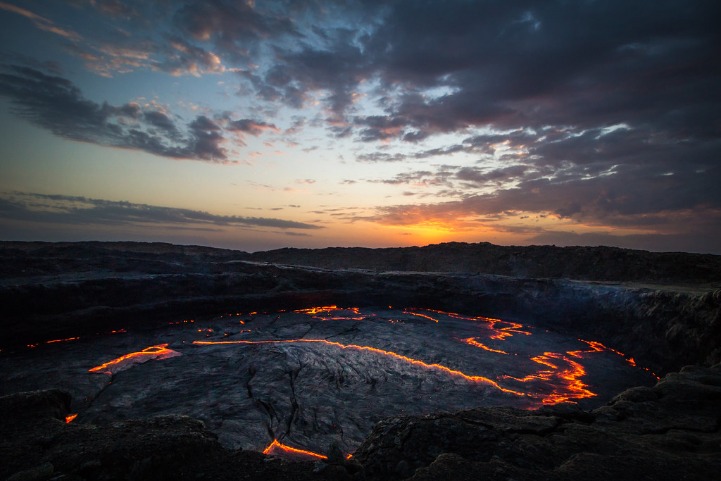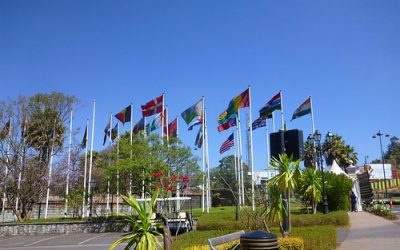Geography and Location of Erta Ale
Erta Ale is a remarkable volcano located in northeastern Ethiopia, renowned for its persistent lava lake. Situated within the Danakil Desert, it lies close to the border with Eritrea and is part of the Afar Triangle, a geologically active region. Its unique location makes it one of the most accessible active volcanoes in the world, attracting adventurers and scientists alike to explore its fiery summit and the surrounding rugged landscape.
Geographical Features
Erta Ale is a prominent volcanic formation located in the Danakil Depression of northeastern Ethiopia. It is renowned for its persistent lava lake, making it one of the few volcanoes in the world with such an active feature. Situated near the border with Eritrea, Erta Ale sits at approximately 613 meters (2,011 feet) above sea level, rising sharply from the surrounding plains.
The volcano is part of the Afar Triangle, a tectonically active region characterized by rifting and volcanic activity resulting from the divergence of the African and Arabian tectonic plates. The area is marked by rugged terrain, deep gorges, and vibrant mineral deposits that give it a colorful landscape. The geographical features of Erta Ale include a caldera, lava channels, and multiple craters, contributing to its dramatic and unique environment.
Proximity to Border Areas
Erta Ale is a prominent volcanic feature located in the Danakil Desert of northeastern Ethiopia. It is situated within the Afar Triangle, an area known for its extreme heat and volcanic activity. The volcano is in close proximity to the border areas of Eritrea and Djibouti, making it a significant geographical landmark in the region. Its remote location adds to its mystique, attracting researchers and adventure enthusiasts alike. The area surrounding Erta Ale is characterized by its rugged terrain, salt flats, and active lava lakes, emphasizing its unique geological significance.
Elevation and Climate
Erta Ale is a prominent volcano located in the Afar Triangle of Ethiopia, known for its active lava lake and geothermal activity. Situated in the northeastern part of Ethiopia, it lies within the Afar Region, near the border with Djibouti. The volcano is part of the East African Rift System, which contributes to its unique geological features.
The elevation of Erta Ale is approximately 613 meters (2,011 feet) above sea level. Despite its relatively modest height compared to other volcanic peaks, its volcanic activity and the presence of one of the few permanent lava lakes make it significant.
The climate around Erta Ale is arid and extreme, characterized by high temperatures during the day, often exceeding 40°C (104°F), and cooler nights. The region experiences little rainfall throughout the year, leading to a desert-like environment that hosts unique flora and fauna adapted to the harsh conditions.
Geological Formation and Volcano Characteristics
Erta Ale in Ethiopia is a remarkable geological formation renowned for its active volcano and unique geothermal features. This volcanic site is a striking example of Earth’s dynamic crust, showcasing the power of volcanic activity and the complex geological processes that shape our planet. Understanding the characteristics of Erta Ale provides insight into volcanic behavior and the formation of the surrounding landscape, making it a fascinating subject for both scientists and adventurers alike.
Type of Volcano
Erta Ale in Ethiopia is a remarkable volcanic formation known for its active lava lake and unique geological features. It is part of the East African Rift System, where tectonic plates are diverging, leading to significant volcanic activity. The volcano is characterized by its persistent lava lake, which has been ongoing for decades, creating a mesmerizing and dangerous landscape.
Erta Ale is classified as a shield volcano, distinguished by its broad, gentle slopes formed by the flow of flowing basaltic lava. Its structure results from low-viscosity magma that spreads out easily, forming extensive lava flows and a large summit crater that contains the active lava lake. The volcano’s explosive activity is also a part of its dynamic nature, although it predominantly exhibits effusive eruptions.
As a volcano, Erta Ale is considered a stratovolcano due to its layered structure formed by alternating eruptions of lava and volcanic ash. However, its primary volcanic type is a shield volcano, which explains its expansive shape and continuous lava pouring activity. The volcano’s activity contributes significantly to the geological evolution of the region and offers valuable insights into volcanic processes associated with rift-related volcanism in Ethiopia.
Caldera Formation
Erta Ale in Ethiopia is a prominent volcanic site known for its unique geological features and active volcanic behavior. It is situated in the Danakil Desert and is part of the East African Rift system, which is characterized by tectonic plate divergence and volcanic activity. The region’s geological formation is shaped by the movement of tectonic plates, resulting in the creation of deep rift valleys, volcanic cones, and geothermal activity.
Volcanoes at Erta Ale exhibit distinctive characteristics, including persistent lava lakes, basaltic eruptions, and steep caldera walls. The volcano’s lava lake is one of the few continuously active lava lakes in the world, providing valuable insights into volcanic processes and magmatic activity. The caldera at Erta Ale was formed through explosive eruptions and the collapse of the volcanic summit, creating a large, basin-like depression.
Caldera formation at Erta Ale involves several stages:
- Initial magma chamber buildup beneath the volcano causes pressure to increase.
- Repeated eruptions of magma and pyroclastic material lead to the gradual emptying of the magma chamber.
- As the magma is depleted, the overlying crust collapses inward, forming a large caldera.
- The caldera often becomes a site for further volcanic activity, including the formation of new cones and lava lakes.
Recent Eruptive Activity
Erta Ale in Ethiopia is a well-known volcanic formation characterized by its persistent lava lake within a large basaltic caldera. The volcano is part of the Afro-Arabian Rift Valley and is famous for its ongoing eruptive activity, which provides valuable insights into volcanic behavior. The caldera measures approximately 2 kilometers across, containing the active lava lake that continuously emits gases and flows, creating a dramatic and dynamic landscape.
Erta Ale’s volcano characteristics include a low shield volcano profile with multiple overlapping cones and fumarolic vents. Its eruptive activity has been ongoing for decades, with the lava lake serving as a prominent feature that frequently varies in size and intensity. The volcano’s recent eruptions have included the inflation and deflation of the lava lake, lava flows, and occasional ash emissions, which pose hazards to nearby inhabitants and influence the surrounding environment. Its active status makes Erta Ale one of the most studied and monitored volcanoes in the region, helping scientists better understand rift volcano dynamics.
Historical Eruptions and Volcanic Activity
Ert’a Ale in Ethiopia has a rich history of volcanic activity and eruptions that have shaped its landscape over centuries. This volcanic region is notable for its eruptions that have influenced local communities, geology, and the environment. Understanding the historical eruptions in Ert’a Ale provides insight into the dynamic nature of Earth’s geology and highlights the importance of monitoring volcanic activity for safety and scientific knowledge.
Notable Past Eruptions
Erta Ale in Ethiopia is one of the most active and historically significant volcanoes in the world. It has a long record of volcanic activity that dates back thousands of years, contributing significantly to the understanding of volcanic behavior and eruptions in the Horn of Africa. Its persistent activity and periodic eruptions have shaped the landscape around the Danakil Depression, making it a site of both scientific interest and cultural importance.
- Historic eruptions at Erta Ale have often been characterized by continuous lava lake activity, with occasional explosive eruptions that have reshaped the caldera and surrounding terrain.
- One of the notable eruptions occurred in 2005, which led to the formation of new fissures and increased lava flow, further expanding the volcano’s summit caldera.
- The volcano has exhibited a pattern of regular activity, with eruptions typically occurring every few years, though the intensity and form vary over time.
- In the 19th and early 20th centuries, Erta Ale’s eruptions were documented by explorers and scientists, providing valuable data on its eruptive cycles and volcanic hazards.
- Recent activity continues to be monitored closely due to the volcano’s potential impact on local communities and its contribution to the geothermal features of the region.
Frequency and Monitoring
Erta Ale in Ethiopia is renowned for its persistent volcanic activity, making it one of the most continuously active volcanoes in the world. The volcano has experienced numerous eruptions throughout history, with some eruptions lasting for weeks or even months, significantly shaping the surrounding landscape. The volcanic activity at Erta Ale is primarily characterized by the persistent lava lake that resides within its caldera, which has been active for many decades, providing valuable insights into volcanic behavior and magma dynamics.
Historically, Erta Ale’s eruptions have ranged from effusive lava flows to more explosive events, although the volcano is predominantly known for its steady lava lake emissions. These eruptions and ongoing volcanic activity have been documented through a combination of field observations, satellite imagery, and seismic monitoring. Monitoring efforts have increased over recent years, using remote sensing technologies, ground-based seismic stations, and gas emission measurements to track changes in activity levels and assess potential eruption risks.
The frequency of eruptions at Erta Ale is relatively high, with the volcano remaining eruptively active for decades, punctuated by periods of heightened activity or dormancy. Due to its remote location and challenging terrain, continuous local monitoring can be difficult. However, modern remote sensing techniques, including satellite surveillance and thermal imaging, have improved the ability to observe and predict eruptions. These monitoring efforts are vital for safeguarding local communities and researchers studying this dynamic and iconic volcano.
Impact on Surroundings
Erta Ale in Ethiopia is renowned for its persistent volcanic activity, particularly its active lava lake that has been continuously flowing for decades. This volcano, located in the Afar Triangle, is a significant geological feature that attracts scientists and tourists alike. Its eruptions have historically shaped the surrounding landscape, creating new landforms and altering existing ones.
The impact of Erta Ale’s eruptions on its surroundings is profound, affecting local ecosystems and human communities. Lava flows can destroy vegetation, habitats, and infrastructure, while ash clouds can impact air quality and climate temporarily. Despite the destructive potential, these volcanic activities also contribute to fertile soils in the region, supporting agriculture and local livelihoods over time.
The eruptions have played a crucial role in the geological evolution of the Afar rift region. Continuous volcanic activity at Erta Ale offers valuable insights into rift dynamics and volcanic processes. Moreover, the volcano’s presence underscores the importance of monitoring and studying active volcanoes to mitigate risks and understand Earth’s geological history better.
Ecology and Environment
Ecology and environment play a vital role in maintaining the balance of natural ecosystems and supporting life on Earth. They encompass the interactions between living organisms and their surroundings, influencing biodiversity and sustainability. In the context of Erta Ale in Ethiopia, understanding these ecological dynamics is essential to appreciate the unique landscapes and the ecological importance of this volcanic region.
Unique Flora and Fauna
Erta Ale in Ethiopia is renowned for its unique ecological and environmental significance, hosting a diverse array of flora and fauna that thrive in its extreme volcanic landscape. This region, part of the Afar Triangle, presents a distinctive ecosystem shaped by harsh climatic conditions, active volcanoes, and mineral-rich soils.
- The region is home to specialized plant species such as succulents and hardy shrubs that are adapted to survive in arid environments with minimal water availability.
- Erta Ale shelters unique fauna including various rodent species, reptiles like lizards and snakes, and migratory birds that utilize the area during specific seasons.
- Among the flora, the endemic and resilient plants play a vital role in preventing soil erosion and maintaining ecological balance in this volatile landscape.
- Specialized insects, including certain beetles and ants, have evolved to withstand extreme temperatures and volcanic activity, contributing to the region’s biodiversity.
- The surrounding areas support pastoral communities who rely on the natural resources, making preservation of this unique flora and fauna essential for sustainable coexistence.
Habitat Characteristics
The ecological and environmental characteristics of Erita Ale in Ethiopia reflect the unique habitat features that support diverse flora and fauna. This region’s habitat is shaped by its geographical location, climate, and natural resources, playing a vital role in maintaining ecological balance and biodiversity.

- Geographical Location: Erita Ale is situated in a mountainous area with varied elevation, which influences local climate and vegetation patterns.
- Climate: The region experiences a temperate climate with seasonal rainfall, essential for sustaining agricultural activities and natural ecosystems.
- Vegetation: The habitat is characterized by woodlands, shrublands, and grasslands that support various plant species adapted to the local environment.
- Wildlife: The area hosts diverse animal species, including endemic birds, small mammals, and insects that thrive in its natural habitats.
- Natural Resources: Erita Ale benefits from rich soil and water sources, which are crucial for farming and sustaining both human and ecological communities.
Conservation Status
Erta Ale in Ethiopia is a fascinating volcanic feature that plays a significant role in the region’s ecology and environment. The volcanic activity creates unique landscapes and habitats that influence local biodiversity. Protecting this area is crucial to preserve its ecological importance and prevent environmental degradation caused by human activities and natural processes.
- Erta Ale is one of the few volcanoes worldwide with a persistent lava lake, which forms an essential part of the local geological ecology.
- The surrounding environment features semi-arid conditions with sparse vegetation, supporting specialized plant and animal species adapted to harsh climates.
- Frequent volcanic eruptions pose challenges to conservation efforts by altering habitats and impacting local ecosystems.
- The conservation status of Erta Ale is of global interest, with efforts focused on monitoring volcanic activity and preserving the unique geological features.
- Local communities depend on the land for grazing and resources, making sustainable management crucial for ecological balance and environmental protection.
Tourism and Accessibility
Tourism and accessibility play a vital role in showcasing the rich cultural heritage and natural beauty of Eerta Ale, Ethiopia. Ensuring that all visitors, including those with mobility challenges, can experience the site enhances its appeal and promotes inclusive travel. By improving access, Eerta Ale can welcome a diverse range of tourists, fostering economic growth and cultural exchange in the region.
Visiting Erta Ale
Visiting Erta Ale in Ethiopia offers a unique adventure for travelers interested in experiencing one of the most active volcanoes in the world. Accessibility to this remote location can be challenging due to difficult terrain and limited infrastructure, but well-organized tours and guided expeditions make it achievable for adventurous tourists. It is important for visitors with mobility issues to plan ahead and consider the physical demands of the trek, as trails can be steep and rugged. Proper preparation, including suitable gear and acclimatization, ensures a safer and more enjoyable experience. Erta Ale’s mesmerizing lava lake and other geothermal features attract many thrill-seekers and nature enthusiasts, making accessible tourism initiatives crucial to help more people explore this extraordinary natural wonder in Ethiopia.
Challenges and Safety Considerations
Tourism in Erta Ale, Ethiopia, offers a unique adventure for travelers seeking breathtaking volcanic landscapes and rugged terrains. Ensuring accessibility for all visitors remains a challenge due to the remote location and difficult terrain, which can limit participation for some tourists. Safety considerations are paramount, as the volcano’s active status poses risks such as eruptions, toxic gases, and unstable ground. Proper planning and guidance are essential to mitigate these dangers and provide a safe experience for adventurers.
- Remote Location and Difficult Terrain: The volcanic region is situated in a remote area, requiring strenuous hikes and travel on unpaved paths, which can be inaccessible for people with mobility impairments.
- Limited Infrastructure: Infrastructure for transportation, accommodation, and medical facilities is minimal, complicating accessibility and safety measures.
- Volcanic Activity Risks: The active nature of Erta Ale increases hazards like gas emissions, lava flows, and sudden eruptions that can threaten visitors.
- Health and Safety Precautions: Visitors need to be equipped with appropriate gear, guides, and knowledge about emergency procedures to ensure safety during their expedition.
- Environmental Impact and Preservation: Ensuring tourism does not harm the fragile ecosystem requires sustainable practices and visitor education about preserving the area’s natural beauty.
Guided Tours and Regulations
Tourism in Erta Ale, Ethiopia, offers a unique experience for travelers seeking adventure and natural wonders. Ensuring accessibility for all visitors is essential to promote inclusive tourism and allow everyone to enjoy this remarkable destination.
Guided tours are a popular way for visitors to explore Erta Ale, providing safety, local insights, and expert navigation through its challenging volcanic landscape. Tour operators often coordinate trips that include safety gear, transportation, and expert guides familiar with the terrain and conditions.
Regulations surrounding tourism at Erta Ale are put in place to protect both tourists and the environment. Visitors are typically required to obtain permits, adhere to designated pathways, and follow safety protocols. These rules help prevent accidents and preserve the delicate ecosystem around the volcano.
- Accessibility improvements include designated pathways, information for visitors with disabilities, and transportation options tailored to various needs.
- Guided tours are often organized by local agencies that ensure safety standards and provide educational experiences about the region’s geology and culture.
- Regulations are enforced by Ethiopian authorities, requiring permits, adhering to safety procedures, and minimizing environmental impact to sustain the region’s natural beauty.

Cultural and Local Significance
Erta Ale, located in Ethiopia, is a site of profound cultural and local significance, revered by local communities and visitors alike. This active volcano not only shapes the landscape but also holds deep spiritual and historical importance for the indigenous people. Its imposing presence serves as a symbol of resilience and natural power, reflecting the rich cultural heritage of the region and its influence on local traditions and folklore.
Local Communities near Erta Ale
Erta Ale in Ethiopia holds profound cultural and local significance for the indigenous Afar people. This active volcano is considered a sacred site, often associated with legends and traditional beliefs that emphasize its spiritual importance. The local communities nearby have long revered the volcano as a symbol of strength and resilience, often integrating it into their storytelling and cultural practices. Additionally, Erta Ale’s geothermal activity plays a vital role in supporting local livelihoods, providing opportunities for geothermal energy exploitation and attracting adventurous tourism that benefits the surrounding communities.
Mythology and Cultural Beliefs
Erta Ale, located in Ethiopia, holds deep cultural and local significance for the surrounding communities. It is revered not only as a natural wonder but also as a spiritual symbol, representing the power and mystery of the earth’s fiery core. Local tribes highly regard the volcano, often incorporating it into their traditions, stories, and rituals, viewing it as a divine force that influences their daily lives.
In Ethiopian mythology and cultural beliefs, Erta Ale is often associated with legends of creation and transformation. Some stories describe the volcano as a gateway to the underworld or a dwelling place of spirits and deities. The persistent activity of the volcano is seen as a testament to the earth’s vitality and the ongoing struggle between destruction and renewal, themes commonly explored in the region’s mythological narratives.
These cultural beliefs and mythologies contribute to a profound respect for Erta Ale, fostering a sense of awe and reverence among local populations. The volcano remains a powerful cultural icon, symbolizing resilience, the raw power of nature, and the spiritual connection between the land and its people.
Role in Local Economy
Erta Ale in Ethiopia holds profound cultural and local significance as a sacred site for many local communities, particularly the Afar people. It is revered not only for its stunning volcanic landscape but also as a symbol of resilience and natural heritage. The active volcano is often integrated into local folklore and traditional practices, reinforcing its spiritual importance. Additionally, Erta Ale attracts scientists and adventurers, contributing to a broader appreciation of Ethiopia’s geological diversity.
Furthermore, Erta Ale plays a vital role in the local economy by boosting tourism in the region. Visitors from around the world travel to witness its mesmerizing lava lake and unique volcanic activity, creating opportunities for local guides, hospitality services, and transportation providers. The influx of tourists fosters employment and stimulates small-scale businesses, helping to sustain communities in the otherwise remote Afar region. Overall, Erta Ale’s cultural significance and tourism potential are essential to the social and economic development of the area.
Research and Scientific Interest
Research and scientific interest play a crucial role in understanding and addressing the various challenges faced by Erta Ale in Ethiopia. By exploring the geological, environmental, and socio-economic aspects of this unique region, scholars and scientists can contribute to sustainable development and conservation efforts. Investment in research fosters innovation and provides valuable insights for policymakers and local communities alike, ensuring the preservation and responsible management of Erta Ale’s natural resources.
Volcanology Studies
Erta Ale volcano in Ethiopia is a focal point of scientific research due to its unique and active volcanic features. Its persistent lava lake offers invaluable insights into volcanic processes, magmatic activity, and the dynamics of rift zone volcanism. Researchers are particularly interested in studying the geophysical and geochemical characteristics of Erta Ale to better understand its eruption patterns and underlying magma systems. The volcano’s continuous activity provides a natural laboratory for monitoring volcanic behavior in real-time, contributing to broader volcanic hazard assessment and mitigation efforts. Studying Erta Ale not only advances our knowledge of volcanic phenomena but also enhances our understanding of the East African Rift system and its geological evolution.
Geological Research
Research and scientific interest in geological research in Erta Ale, Ethiopia, focus on understanding the complex volcanic activity and the region’s unique geological features. Erta Ale is renowned for its persistent lava lake, which offers valuable insights into volcanic processes and magmatic dynamics. Scientists are particularly interested in studying the tectonic setting of the Afar Triangle, where Erta Ale is located, as it is a key area for understanding continental rifting and plate tectonics. Ongoing geological research aims to monitor volcanic activity, assess hazards, and explore mineral resources within this geologically active region. Such studies contribute significantly to the broader understanding of volcanic behavior, geothermal potential, and the geological evolution of the East African Rift System.
Environmental Monitoring
Research and scientific interest in environmental monitoring in Erta Ale, Ethiopia, focus on understanding the unique volcanic and geothermal phenomena of the region. This area, characterized by its active lava lakes and geothermal activity, offers valuable insights into volcanic behavior and geothermal energy potential. Scientific studies aim to monitor volcanic activity to predict eruptions, assess environmental impacts, and harness sustainable energy sources. Additionally, environmental monitoring helps track the ecological effects of volcanic activity on local flora and fauna, supporting conservation efforts. Continuous research in Erta Ale contributes to global understanding of volcanic processes and enhances regional disaster preparedness and environmental management strategies.





0 Comments